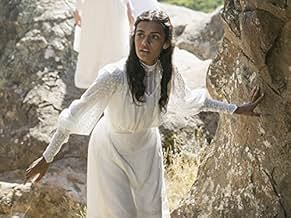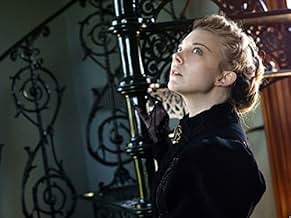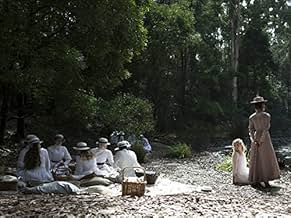NOTE IMDb
6,2/10
4,7 k
MA NOTE
Trois écolières d'un internat et de leur professeure disparaissent à hanging rock (état du Victoria, Australie) le jour de la saint-Valentin en 1900. Cette série est inspirée d'une nouvelle ... Tout lireTrois écolières d'un internat et de leur professeure disparaissent à hanging rock (état du Victoria, Australie) le jour de la saint-Valentin en 1900. Cette série est inspirée d'une nouvelle de Joan Lindsay.Trois écolières d'un internat et de leur professeure disparaissent à hanging rock (état du Victoria, Australie) le jour de la saint-Valentin en 1900. Cette série est inspirée d'une nouvelle de Joan Lindsay.
- Récompenses
- 7 victoires et 10 nominations au total
Parcourir les épisodes
Résumé
Reviewers say 'Picnic at Hanging Rock' is visually stunning with compelling narratives and expanded character backstories, yet criticized for pacing and historical inaccuracies. Praised for performances by Natalie Dormer and young actresses, it faces backlash for casting and deviations from the source material. Lauded for cinematography and production design, it is faulted for over-direction and excessive slow motion. The supernatural elements are both celebrated for mystery and criticized for lacking subtlety and coherence.
Avis à la une
...not because the series was bad, although what I did see was incredibly bad, but because I could not get past the 1990's New Age soundtrack. Not only did it sound more like dinner music played in an desperately upscale restaurant, it had nothing whatsoever to do with the story and was intrusive enough to take me right out of the show and start wondering what Kitaro is doing these days.
People may not be aware that the novel PICNIC AT HANGING ROCK is very short, just over 200 pages. It works ideally as a 2-hour film but to stretch it out into 6-hours results in a heavily padded and downright dull miniseries. In the first hour, the girls disappear and the filmmakers bungle this key scene. There's no set- up, no sense of dread, so the main focus of the entire project falls flat. And that's in the first hour! For the rest of the miniseries, the characters involved seem more concerned about the girl's school than Hanging Rock. We see the local community searching for the girls, but at the same time, backstories of pretty much every character are introduced. Episodes 3 and 4 add zero to the narrative and you can see the filmmakers are desperate to keep us engaged with some poorly staged jump scares: an animal nailed to the wall! A pile of maggots at one character's feet! But why? No explanation. This is a much harsher PICNIC than Peter Weir's classic film of 1975. At times, the miniseries comes across as LA RESIDENCIA (THE HOUSE THAT SCREAMED), the 1970 shocker with Lili Palmer who stars as the headmistress of a nineteenth-century French boarding school for girls. Some girls are whipped, others are slapped...but it isn't until the 5th and 6th episodes that we're reminded girls went missing. Whatever happened to them? Parents come and remove their children from the school and there are more flashbacks and backstories. The women talk about being "free" but that's never explained either. The girls who vanish "take a vow"...to what end? Stretched to the breaking point to six hours, the miniseries tries to answer questions that are never asked and, worst of all, forgets that Hanging Rock is the center of the story, not the school house.
There's so much that's wrong with this new version of the Australian classic that it's hard to know where to start. First there's the direction - tricksy, flashy and sprinkled with "creative" flourishes more evocative of 80s music videos than Australia in 1900. It's uneven from episode to episode, unhelpful in establishing the kind of eerie, dreamy atmosphere that the story demands, and frequently just yanks us out of the period and out of the story. The performances are jarringly uneven too, ranging from naturalistic (though, unfortunately, in an anachronistic contemporary style) to fruity amateur-theatrical emoting, with highly questionable accents. The location for the girl's school is ludicrously lavish, a sprawling mansion replete with marble columns and ornate fixtures - an unlikely girl's school anywhere in Australia at any time, but utterly nonsensical in a remote rural area in 1900. And then there's the depiction of the bush and hanging rock itself - over-saturated hues that make everything seem green and lush, and even a shimmering lake. It looks more English than Australian, and absolutely nothing like the dry Macedon Ranges in which the story is set. The same lack of care extends to the dialogue and the depiction of social conventions of the time, with almost every exchange between "the gentry" and the lower orders being hilariously unlikely. If you watch this Picnic with the expectation of something eerie and other-worldly, you may well find it... and it's most likely the sound of poor Joan Lindsay turning in her grave.
It's unlikely that approximately six hours of TV are required to make a spin-off from a source-novel of less-than two-hundred pages. 'Picnic at Hanging Rock', like Conrad's 'Heart of Darkness', draws power from what's left unsaid. Whereas Joan Lindsay, in the original book, has the imagination to step-inside an earlier time-period, this adaptation simply superimposes twenty-first century mores onto a world where they don't belong. Nearly everyone has become 'pan-sexual'; and it's highly unlikely that a young aboriginal woman would have attended a posh girls' school in Australia c.1900 (no matter how politically correct this might be). The episodes are often terribly over-directed. Natalie Dormer seemed miscast as 'Mrs Appleyard'. 'Miranda', 'Irma' and 'Marion' are played by exquisitely beautiful actresses, but the characters come across as annoying and shallow. Lola Bessis really shines in an expanded characterization of 'Mademoiselle'.
In the 1967 book, the missing girls are kept in the background, becoming more-of an idea or enigmatic symbol. A large part of the novel consists of the author - a woman - writing about women being viewed by men (Michael, a young, upper-class Englishman, and his working-class Aussie friend, Albert). Bringing the senior-boarders right into the foreground distorts the story, producing diminishing returns. And 'Mrs Appleyard' has been disastrously rewritten. More is definitely less in this case.
In the 1967 book, the missing girls are kept in the background, becoming more-of an idea or enigmatic symbol. A large part of the novel consists of the author - a woman - writing about women being viewed by men (Michael, a young, upper-class Englishman, and his working-class Aussie friend, Albert). Bringing the senior-boarders right into the foreground distorts the story, producing diminishing returns. And 'Mrs Appleyard' has been disastrously rewritten. More is definitely less in this case.
The original film still holds up really well, so not totally sure why they needed to remake this. Seems like they spent more time worrying about making it look beautiful then thinking about why it needed a remake.
Le saviez-vous
- AnecdotesNatalie Dormer nicknamed the sunglasses she wears in the series her "Gary Oldman glasses" in reference to similar sunglasses that the actor wore in Dracula (1992).
Meilleurs choix
Connectez-vous pour évaluer et suivre la liste de favoris afin de recevoir des recommandations personnalisées
- How many seasons does Picnic at Hanging Rock have?Alimenté par Alexa
Détails
- Date de sortie
- Pays d’origine
- Site officiel
- Langues
- Aussi connu sous le nom de
- Пікнік біля Навислої скелі
- Lieux de tournage
- Sociétés de production
- Voir plus de crédits d'entreprise sur IMDbPro
- Durée
- 51min
- Couleur
- Mixage
- Rapport de forme
- 2.00 : 1
Contribuer à cette page
Suggérer une modification ou ajouter du contenu manquant





































